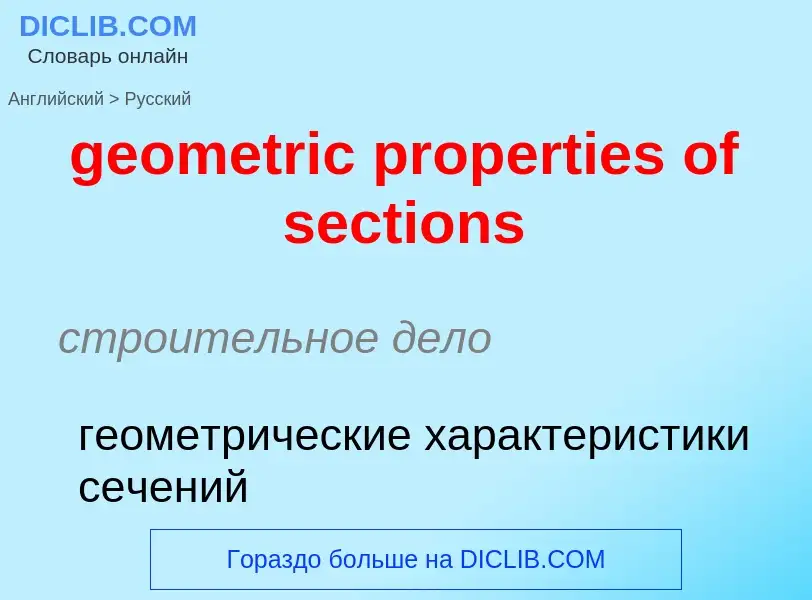Vertaling en analyse van woorden door kunstmatige intelligentie ChatGPT
Op deze pagina kunt u een gedetailleerde analyse krijgen van een woord of zin, geproduceerd met behulp van de beste kunstmatige intelligentietechnologie tot nu toe:
- hoe het woord wordt gebruikt
- gebruiksfrequentie
- het wordt vaker gebruikt in mondelinge of schriftelijke toespraken
- opties voor woordvertaling
- Gebruiksvoorbeelden (meerdere zinnen met vertaling)
- etymologie
geometric properties of sections - vertaling naar russisch
строительное дело
геометрические характеристики сечений
общая лексика
геометрическая прогрессия
Definitie
.
Wikipedia
Geometry (from Ancient Greek γεωμετρία (geōmetría) 'land measurement'; from γῆ (gê) 'earth, land', and μέτρον (métron) 'a measure') is, with arithmetic, one of the oldest branches of mathematics. It is concerned with properties of space such as the distance, shape, size, and relative position of figures. A mathematician who works in the field of geometry is called a geometer.
Until the 19th century, geometry was almost exclusively devoted to Euclidean geometry, which includes the notions of point, line, plane, distance, angle, surface, and curve, as fundamental concepts.
During the 19th century several discoveries enlarged dramatically the scope of geometry. One of the oldest such discoveries is Carl Friedrich Gauss' Theorema Egregiumcode: lat promoted to code: la ("remarkable theorem") that asserts roughly that the Gaussian curvature of a surface is independent from any specific embedding in a Euclidean space. This implies that surfaces can be studied intrinsically, that is, as stand-alone spaces, and has been expanded into the theory of manifolds and Riemannian geometry.
Later in the 19th century, it appeared that geometries without the parallel postulate (non-Euclidean geometries) can be developed without introducing any contradiction. The geometry that underlies general relativity is a famous application of non-Euclidean geometry.
Since then, the scope of geometry has been greatly expanded, and the field has been split in many subfields that depend on the underlying methods—differential geometry, algebraic geometry, computational geometry, algebraic topology, discrete geometry (also known as combinatorial geometry), etc.—or on the properties of Euclidean spaces that are disregarded—projective geometry that consider only alignment of points but not distance and parallelism, affine geometry that omits the concept of angle and distance, finite geometry that omits continuity, and others.
This enlargement of the scope of geometry led to a change of meaning of the word "space", which originally referred to the three-dimensional space of the physical world and its model provided by Euclidean geometry; presently a geometric space, or simply a space is a mathematical structure on which some geometry is defined.
Originally developed to model the physical world, geometry has applications in almost all sciences, and also in art, architecture, and other activities that are related to graphics. Geometry also has applications in areas of mathematics that are apparently unrelated. For example, methods of algebraic geometry are fundamental in Wiles's proof of Fermat's Last Theorem, a problem that was stated in terms of elementary arithmetic, and remained unsolved for several centuries.

![Calabi–Yau threefold]] Calabi–Yau threefold]]](https://commons.wikimedia.org/wiki/Special:FilePath/Calabi yau.jpg?width=200)
![Visual checking of the [[Pythagorean theorem]] for the (3, 4, 5) [[triangle]] as in the [[Zhoubi Suanjing]] 500–200 BC. The Pythagorean theorem is a consequence of the [[Euclidean metric]]. Visual checking of the [[Pythagorean theorem]] for the (3, 4, 5) [[triangle]] as in the [[Zhoubi Suanjing]] 500–200 BC. The Pythagorean theorem is a consequence of the [[Euclidean metric]].](https://commons.wikimedia.org/wiki/Special:FilePath/Chinese pythagoras.jpg?width=200)

![hyperbolic plane]] hyperbolic plane]]](https://commons.wikimedia.org/wiki/Special:FilePath/Order-3 heptakis heptagonal tiling.png?width=200)
![A thickening of the [[trefoil knot]] A thickening of the [[trefoil knot]]](https://commons.wikimedia.org/wiki/Special:FilePath/Trefoil knot arb.png?width=200)
![The [[Koch snowflake]], with [[fractal dimension]]=log4/log3 and [[topological dimension]]=1 The [[Koch snowflake]], with [[fractal dimension]]=log4/log3 and [[topological dimension]]=1](https://commons.wikimedia.org/wiki/Special:FilePath/Von Koch curve.gif?width=200)
![European]] and an [[Arab]] practicing geometry in the 15th century European]] and an [[Arab]] practicing geometry in the 15th century](https://commons.wikimedia.org/wiki/Special:FilePath/Westerner and Arab practicing geometry 15th century manuscript.jpg?width=200)

